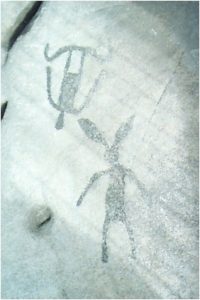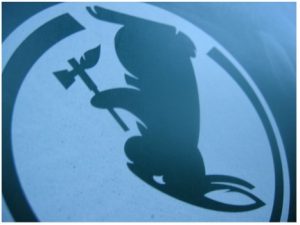In the previous section, we considered critical approaches that might guide our reading of Moon of the Crusted Snow as an example of Anishinaabe horror. In this section, we will apply those approaches by conducting a focused analysis of key excerpts from the novel.
Time and/as Infrastructure
While reading and discussing Moon of the Crusted Snow, it may be useful (and, indeed, unavoidable) to consider how our own real-life experiences of the global COVID-19 pandemic of recent years now affects our appreciation of the novel’s similarly apocalyptic events. Along these lines, one of Moon of the Crusted Snow’s more pronounced “breaks” with the status quo involves a disruption in how the characters experience the passage of time—much of which is closely tied to the functioning of electrical and fossil fuel machinery. Evan jokes to himself early on that the feeling of having to rely solely on radio for long-distance communication is like “going back in time” (20). Perhaps more familiar to contemporary readers (post-COVID, at least) are Isaiah and Tyler’s respective lamentations that “Toronto woulda been in a playoff spot by now” and “Just watch, all this shit’s gonna come back on, and they’ll be in the playoffs. They probably been playing this whole time, and we just been in the dark” (154). Tyler’s joke, if anything, raises an astute point about time: landmark events like the annual hockey playoffs are indeed crucial to how we measure and organize the passage of time for ourselves. That need to make sense of time is disrupted when those seasonal landmarks go unpracticed, as they effectively do when the community’s access to sports news coverage is cut off.
Another way that Rice plays with understandings of time is with expectations of progress and utility—expectations which, as the novel makes clear, are established (and often swiftly abandoned) by Canadian settlers rather than by Indigenous communities. Consider how Rice characterizes the location of the fictional Gaawaandagkoong First Nationwhere the novel takes place. Much of the infrastructure that allows the reserve to live in relative comfort was, according to the novel, brought up north for the purposes of resource extraction and then left behind by Canadian settlers. Evan’s brother Cam and his friends, for instance, “lived in the cluster of duplex buildings originally built for hydro workers, but after the men from the South left, the housing was made available to band members. It was temporary housing for the southerners but, like so much on the rez, it stayed up and got used” (33). Part of what Rice asks us to keep in mind here is that, under the Indian reserve system, First Nations communities do not get to choose where and how they live. These conditions are, to return to Alicia Elliot’s terms, post-apocalyptic: “Rice is Anishinaabe, which means he comes from a nation that has already survived a sort of apocalypse. In fact, most Indigenous people have already dealt with apocalyptic illnesses; that’s one of the ways this country was colonized” (Elliott, “After the Crisis”).
As Rice presents it, there are a few clear ironies here. For one, the hydroelectric power that those “men from the South” worked to extract from the North is doomed and futile—it ends abruptly early in the novel. For another, the North-South divide (which is presented in geographic terms but also reflects divisions between the up-north Anishinaabe and the down-south settlers) implies a narrative of progress that the novel later subverts. If “progress” originally meant to extract resources from the North in order to fuel the South, Moon of the Crusted Snow reverses the script by revealing that “Northern Development”1 also does the opposite: for better or worse, it brings infrastructure like roads, housing, and supply chains into the North that will remain useful even after the South has done its business and left. On this last point, there is also the irony that the novel begins from a kind of post-apocalyptic perspective, insofar as the Anishinaabe community in the story thrives on the discarded scraps of settler development and progress in the inhospitable North. In the grand scheme of “progress,” the Anishinaabe families that now occupy these duplexes are very much an unintended afterthought, yet they are the ones who continue to make the most equitable and least wasteful use of that abandoned infrastructure.
Old Stories: Dreams of Nanabush

A depiction of Nanabush in the form of a rabbit. “Nanabush, the Trickster” by Lone Primate is licensed under CC BY-NC-SA 2.0.
Rice incorporates and adapts traditional Anishinaabe stories into Moon of the Crusted Snow through the roles that both the frightening wendigo and Nanabush the trickster play in the novel. Nanabush (also spelled Nana’b’oozoo) is a central figure in Anishinaabe oral traditions. Depending on the story and context in which he appears, Nanabush is a malleable character—sometimes comical and buffoonish, sometimes horrifically violent and callous. Ojibway (Anishinaabe) oral historian Basil H. Johnston emphasizes Nanabush’s dual status as both a manitou2 and a human, which allows him to commit both supernatural feats and uniquely human mistakes (78).
The Nanabush story told by Dan to his grandchildren Nangohns and Maiingan in chapter twenty-five of Moon of the Crusted Snow is similarly multilayered in its messaging, especially when it comes to the depiction of violence. As with many aspects of the novel, Dan’s version of Nanabush is both funny and frightening. Dan’s Nanabush plays an “evil trick” on a gaggle of migrating geese by luring them into a false sense of security before strangling them one by one, leaving “thirty geese lying there dead” (172). Dan’s Nanabush massacres the geese out of laziness, since he has neglected to save up food for the coming winter; this laziness and wastefulness also leads to Nanabush’s downfall when he falls asleep and wakes up to find the dead geese have been stolen. When asked by Dan to identify “any other important lessons in that story,” Maiingan and Evan answer respectively with “Don’t be greedy” and “always be ready for winter” (174).

A depiction of Nanabush as a beaver. “Nanabush” by a L p is licensed under CC BY-SA 2.0.
As a horror story appearing within another horror story, Dan’s Nanabush tale can be understood as a distillation of the novel’s concern with sustainability, resource management, and resurgence. How, along these lines, can we make sense of Dan’s take on the Nanabush character? In her writings on the Anishinaabe oral tradition, Leanne Betasamosake Simpson calls Nanabush “our first intellectual” and “the first researcher” (56, 57). That is, they3 are the Anishinaabe model of a learner as well as a teacher. As a student who “walked the world twice after it was created,” Nanabush endeavours to “understand their place in it, our place in it, to create face-to-face relationships with other nations and beings” (Simpson 56-57). The knowledges and relationships built during Nanabush’s journeys are what in turn inform Anishinaabe traditions as they are known today. While Nanabush is ultimately a figure of reverence, they also, as Dan reminds us in Moon of the Crusted Snow, play the role of “the trickster” in Anishinaabe stories. Simpson, for instance, mentions a series of stories in which Nanabush “experiments with capitalist modes of production when he tries to get various beings—skunks, ducks, geese, for example—to do the hard work of life for his own personal gain and accumulation. He tries in various stories to outsource the work of feeding himself, and disaster ensues” (79). These stories, in which an immature Nanabush makes mistakes and suffers their consequences, are cautionary—Nanabush is an example of how not to behave. If we understand Dan’s Nanabush story as one of these anti-capitalist stories, we can better appreciate how and why Rice builds this particular example from the Anishinaabe oral tradition into the novel. In the context of Moon of the Crusted Snow, Nanabush functions as a kind of slapstick scientist who, by means of a botched (and horrifically violent) experiment, gains valuable knowledge about how (not) to manage one’s resources in times of crisis.
Questions to Consider for Further Analysis
- To echo Dan’s question to Maiingan and Nangohns: “Can you think of any other lessons in that [Nanabush] story?” The Nanabush story that Rice includes in Moon of the Crusted Snow casts a thematic shadow over the rest of the novel. If we are to analyze the story in depth, we will need to identify specific details in the text that resonate between the main narrative and the story-within-the-story. Beyond the stated message of “Don’t be greedy,” what further points of resonance do you notice between, for instance, Nanabush’s actions and those of other characters in Moon of the Crusted Snow (e.g., Evan Whitesky and Justin Scott)? Are these examples cautionary, as with Nanabush, or do they teach us something different and more complex?
Notes
- The Canadian federal ministry responsible for administering the Indian Act was known as “Department of Indian Affairs and Northern Development” from 1966-2011, then “Aboriginal Affairs and Northern Development Canada” from 2011-2015, then Indigenous and Northern Affairs Canada (INAC) until 2017, when INAC was replaced by two new departments: Crown-Indigenous Relations and Northern Affairs Canada, and Indigenous Services Canada.
- Literally, in Anishinabemowin, a “mystery,” but the term also connotes “property, essence, transcendental, mystical, muse, patron, and divine” (Johnston 2).
- Simpson uses both “he” and “they” pronouns when referring to Nanabush.
Works Cited
- Elliott, Alicia. “After the Crisis, What Kind of World Do We Want? Post-Apocalyptic Novels Hold Lessons—and Warnings.” CBC Arts, 26 Mar. 2020, cbc.ca/arts/after-the-crisis-what-kind-of-world-do-we-want-post-apocalyptic-novels-hold-lessons-and-warnings-1.5509721.
- Johnston, Basil H. The Manitous: The Spiritual World of the Ojibway. Key Porter, 1995.
- Rice, Waubgeshig. Moon of the Crusted Snow. ECW, 2018.
- Simpson, Leanne Betasamosake. As We Have Always Done: Indigenous Freedom through Radical Resistance. U of Minnesota P, 2017.








 ©
©